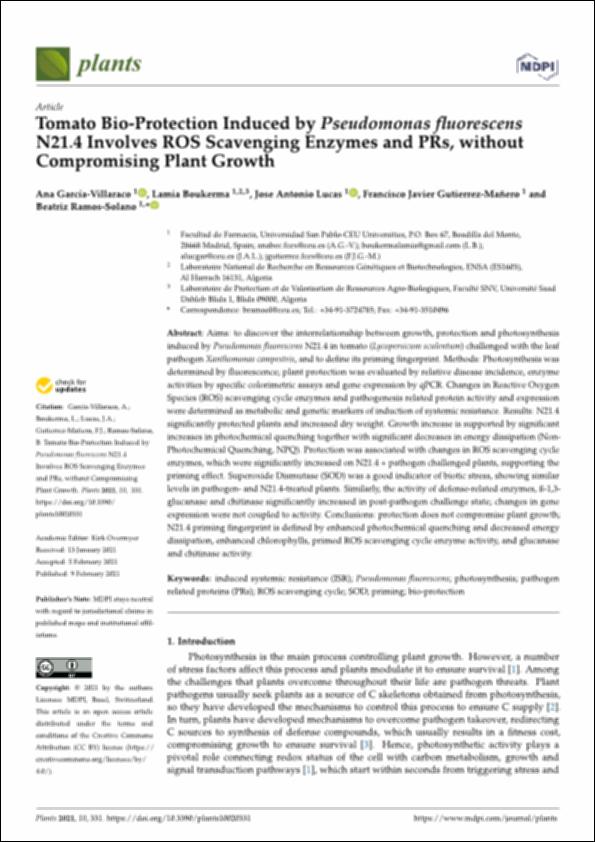Please use this identifier to cite or link to this item:
http://hdl.handle.net/10637/15901Tomato Bio-Protection Induced by Pseudomonas fluorescens N21.4 Involves ROS Scavenging Enzymes and PRs, without Compromising Plant Growth
| Title: | Tomato Bio-Protection Induced by Pseudomonas fluorescens N21.4 Involves ROS Scavenging Enzymes and PRs, without Compromising Plant Growth |
| Authors : | García Villaraco, Ana Boukerma, Lamia Lucas García, José Antonio Gutiérrez Mañero, Francisco Javier Ramos Solano, Beatriz |
| Keywords: | Fotosíntesis; Pseudomonas fluorescens |
| Publisher: | MDPI |
| Citation: | García-Villaraco, A.; Boukerma, L.; Lucas, J.A.; Gutierrez-Mañero, F.J.; Ramos-Solano, B. Tomato Bio-Protection Induced by Pseudomonas fluorescens N21.4 Involves ROS Scavenging Enzymes and PRs, without Compromising Plant Growth. Plants 2021, 10, 331. https://doi.org/10.3390/ plants10020331 |
| Abstract: | Aims: to discover the interrelationship between growth, protection and photosynthesis induced by Pseudomonas fluorescens N21.4 in tomato (Lycopersicum sculentum) challenged with the leaf pathogen Xanthomonas campestris, and to define its priming fingerprint. Methods: Photosynthesis was determined by fluorescence; plant protection was evaluated by relative disease incidence, enzyme activities by specific colorimetric assays and gene expression by qPCR. Changes in Reactive Oxygen Species (ROS) scavenging cycle enzymes and pathogenesis related protein activity and expression were determined as metabolic and genetic markers of induction of systemic resistance. Results: N21.4 significantly protected plants and increased dry weight. Growth increase is supported by significant increases in photochemical quenching together with significant decreases in energy dissipation (Non-Photochemical Quenching, NPQ). Protection was associated with changes in ROS scavenging cycle enzymes, which were significantly increased on N21.4 + pathogen challenged plants, supporting the priming effect. Superoxide Dismutase (SOD) was a good indicator of biotic stress, showing similar levels in pathogen- and N21.4-treated plants. Similarly, the activity of defense-related enzymes, ß-1,3-glucanase and chitinase significantly increased in post-pathogen challenge state; changes in gene expression were not coupled to activity. Conclusions: protection does not compromise plant growth; N21.4 priming fingerprint is defined by enhanced photochemical quenching and decreased energy dissipation, enhanced chlorophylls, primed ROS scavenging cycle enzyme activity, and glucanase and chitinase activity. |
| URI: | http://hdl.handle.net/10637/15901 |
| Rights : | http://creativecommons.org/licenses/by-nc-nd/4.0/deed.es Open Access |
| ISSN: | 2223-7747 |
| Issue Date: | 9-Feb-2021 |
| Center : | Universidad San Pablo-CEU |
| Appears in Collections: | Facultad de Farmacia |
Items in DSpace are protected by copyright, with all rights reserved, unless otherwise indicated.


